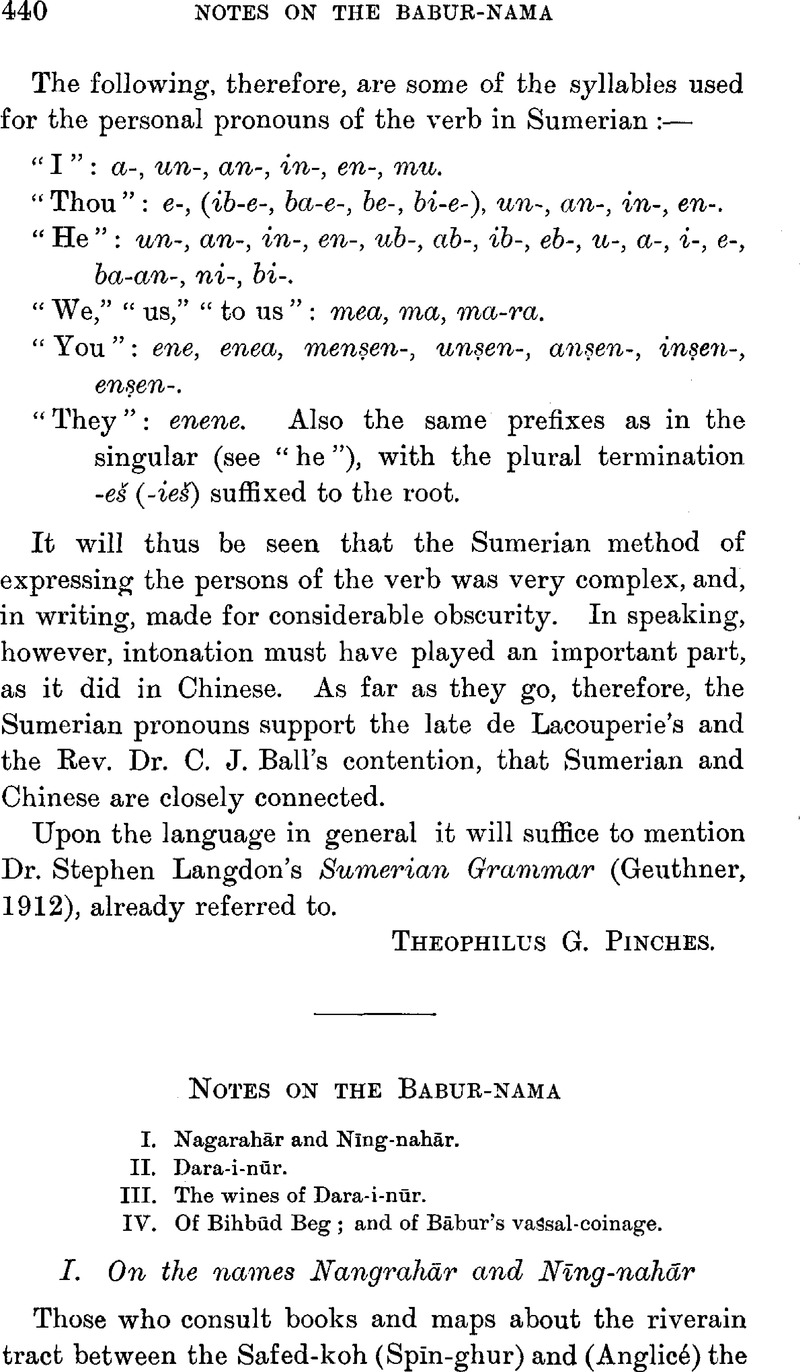No CrossRef data available.
Published online by Cambridge University Press: 15 March 2011

page 441 note 1 Another but less obvious objection will be mentioned later.
page 442 note 1 Julien notes (Voyages des pélerins Bouddhistes, ii, 96)Google Scholar, “Dans les annales des Song on trouve Nang-go-lo-ho, qui répond exactement à l'orthographe indienne Nangarahāra, que fournit l'inscription découvert par le capitaine Kittoe” (JASB. 1848). The reference is to the Ghoswāra inscription, of which Professor Kielhorn has also written (Indian Antiquary, 1888)Google Scholar, but with departure from Nangarahāra to Nagarahāra.
page 442 note 2 The scribe of the Ḥaidarābād Codex appears to have been somewhat-uncertain as to the spelling of the name. What is found in histories is plain, N: g: r: hār. The other name varies; on first appearance (fol. 131b) and also on fols. 144 and 154b, there is a vagrant dot below the word, which if it were above would make Nīng-nahār. In all other cases the word reads N: g: nahār. Nahār is a constant component, as is also the letter g (or k).
page 443 note 1 Some writers express the view that the medial r in this word indicates descent from Nagarahāra, and that the medial n of Elphinstone's second form is a corruption of it. Though this might be, it is true also that in local speech r and n often interchange, e.g. Chighār and Chighān-sarāī, Sūhār and Sūhān (in Nūr-valley).
page 443 note 2 This asserts n to be the correct consonant, and connects with the interchange of n and r already noted.
page 443 note 3 Since writing the above I have seen Laidlaw's almost identical suggestion of a nasal interpolated in Nagarahāra (JASB. 1848, art. on Kittoe). The change is of course found elsewhere; is not Tānk for ![]() āq an instance?
āq an instance?
page 445 note 1 These affluents I omit from main consideration as sponsors because they are less obvious units of taxable land than the direct affluents of the Kābul-river, but they remain a reserve force of argument and may or may not have counted in Babur's nine.
page 445 note 2 Cunningham, , i, 42Google Scholar. My topic does not reach across the Kābul-river to the greater Udyānapūra of Beal, 's Buddhist Records (p. 119)Google Scholar nor raise the question of the extent of that place.
page 446 note 1 The strong form Nīng-nahār is due to euphonic impulse.
page 450 note 1 Ḥabību's-siyar iii, 227Google Scholar. For discussion on the Bih būd of Ḥusain's coins, JRAS., 1913Google Scholar, 1914, Notes by Dr. Codrington, Mr. M. L. Dames, and Mr. H. Beveridge. For particulars of the Bābur-nāma passage, Memoirs of Bābur trs. ASB. Fasc. II, Appendix H.
page 450 note 2 l.c. iii, 219.
To send this article to your Kindle, first ensure no-reply@cambridge.org is added to your Approved Personal Document E-mail List under your Personal Document Settings on the Manage Your Content and Devices page of your Amazon account. Then enter the ‘name’ part of your Kindle email address below. Find out more about sending to your Kindle. Find out more about saving to your Kindle.
Note you can select to save to either the @free.kindle.com or @kindle.com variations. ‘@free.kindle.com’ emails are free but can only be saved to your device when it is connected to wi-fi. ‘@kindle.com’ emails can be delivered even when you are not connected to wi-fi, but note that service fees apply.
Find out more about the Kindle Personal Document Service.
To save this article to your Dropbox account, please select one or more formats and confirm that you agree to abide by our usage policies. If this is the first time you used this feature, you will be asked to authorise Cambridge Core to connect with your Dropbox account. Find out more about saving content to Dropbox.
To save this article to your Google Drive account, please select one or more formats and confirm that you agree to abide by our usage policies. If this is the first time you used this feature, you will be asked to authorise Cambridge Core to connect with your Google Drive account. Find out more about saving content to Google Drive.